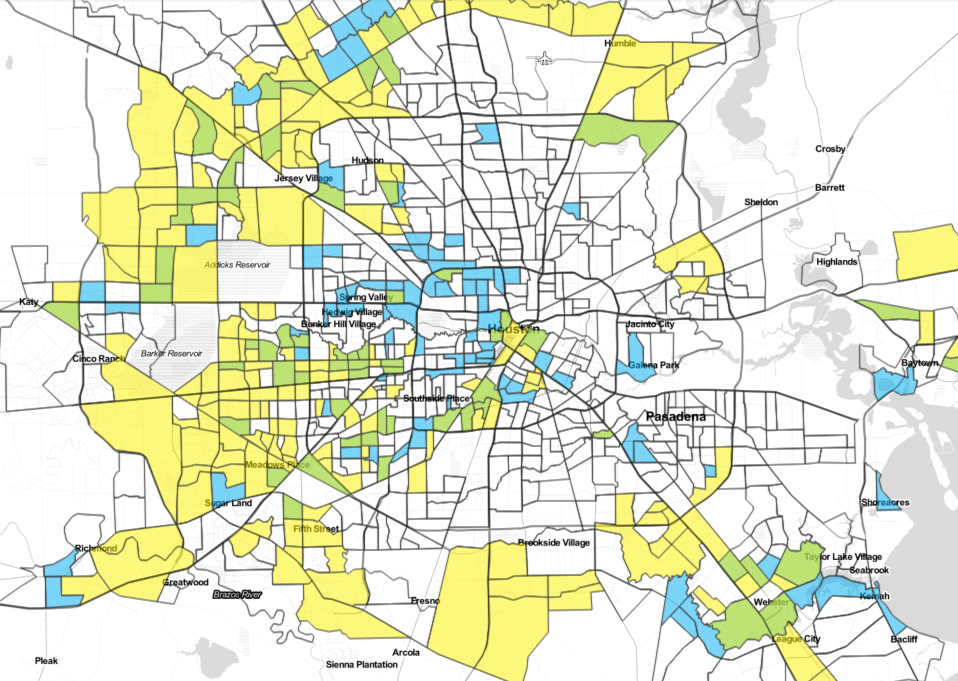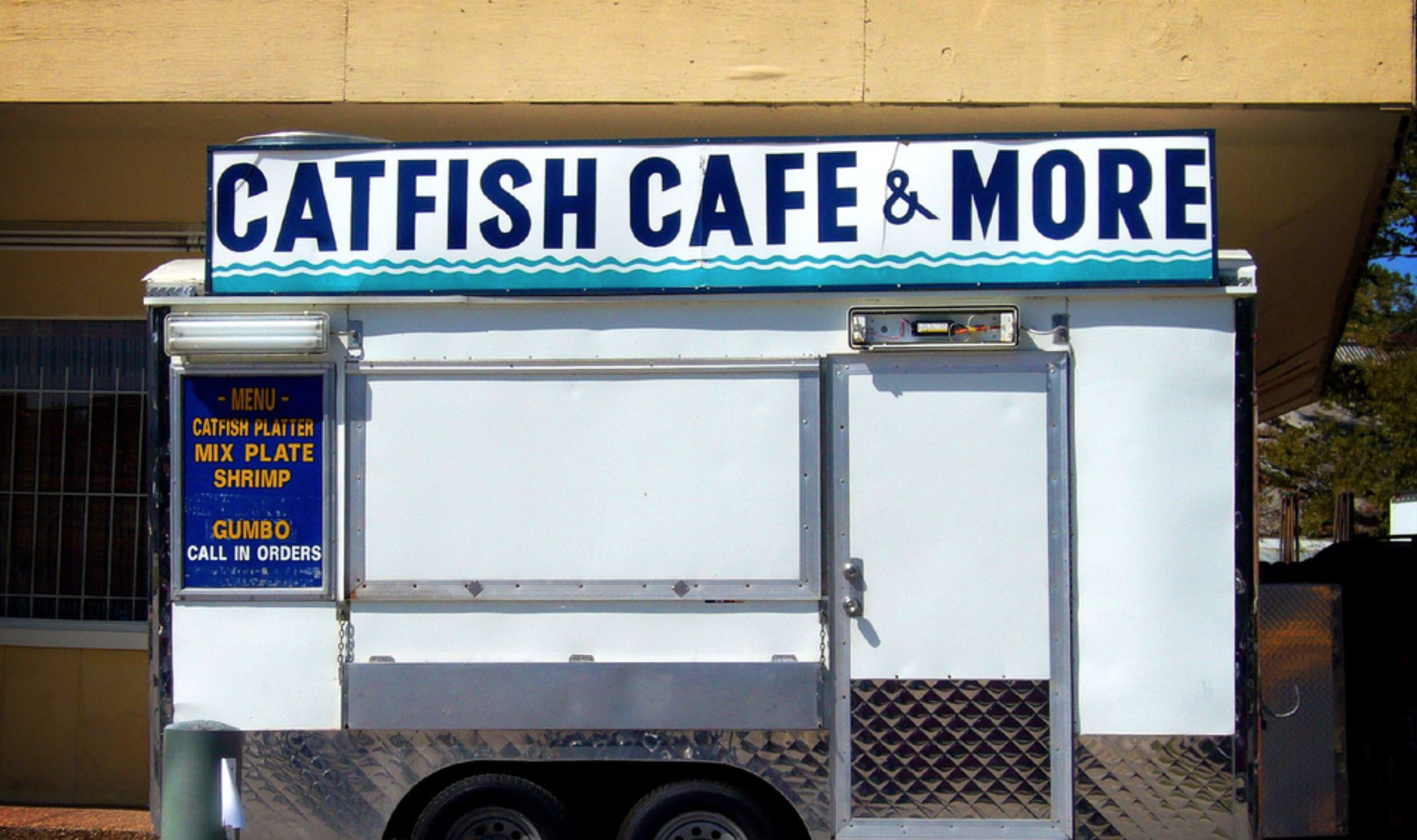At an Eid al-Fitr celebration at the Indonesian consulate in Houston, Dian Ardhini is busy greeting the families coming through the door. Just a few months into a three-year assignment with the consulate, Ardhini would normally celebrate the end of Ramadan with her large, extended family back in Indonesia.
But today, she’s playing host to an even larger party, ushering people in to the buffet at the far side of the room where she’ll later scoop spoonfuls of rice cake onto their plates. Traditionally, the cakes are cooked overnight inside tiny woven baskets made of coconut leaves but here, she said, there’s the instant kind.
“It’s easy to find Asian products here,” said Ardhini. And this year, at the start of the holy month, her Afghan neighbors next door gave them a basket of food, tea and cooking oils. With her husband Didit Prayogo, Ardhini lives in a Westchase apartment blocks from the consulate in an area known for its diverse mix of immigrants. Because Indonesia is itself home to hundreds of languages, the setting feels both different and familiar.
Communities like this have become the focus of a national narrative that has, at last, recognized Houston as something other than its big-haired, big talking cowboy town stereotype. That was the heart of Anthony Bourdain’s “Parts Unknown” visit here, in which he confronted his own misconceptions about the city that likes to call itself the most diverse in the country. His death set off a flurry of appreciations for an approach to documenting places and people that did its best to upend the paternalistic, colonial tropes that characterized much of travel and food writing before him and even still. It was cultural consumption that tried to keep the culture part intact. Cities, as sites of consumption and production, figured centrally in his work and there are lessons here for urbanists and people committed to making cities work for everyone. In Houston, in particular, Bourdain found not just the opposite of the stereotypical bigoted, backwards place he thought it was, but, perhaps, the antidote to all that.
Houston celebrated this reading and has positioned itself as the place where, as the Kinder Institute’s own founding director often puts it, America’s future as a multicultural country will be worked out. Within that episode, Houstonians praise the region as welcoming and inclusive. Where New Yorkers, for example, fight about what makes you a true New Yorker, it seems newcomers can call themselves Houstonians right after signing the lease. But like the city itself, a canvas of pockmarked streets, rising and falling bayous and tumbling Gulf Coast greenery threatening always to overtake the order imposed upon it, things get messy fast.


What’s your favorite thing about Houston?
The food?
The diversity?
You hear both frequently and, of course, they’re connected. But, as in other conversations about cities and diversity, particularly in earnest efforts to celebrate that diversity and to come to the table as equals, there are some important notes in the margin here.
“You may go and eat the food and that’s good, that’s the first step,” said David Leftwich, a food writer who interweaves history into his wandering chronologies of Houston’s food scene, “but are you understanding more about why a particular culture came here?” Food is a convenient way to learn the vocabulary of different places and people. It’s an entry point. For food to tell its stories, however, you have to listen.
So when celebrity urbanist Richard Florida writes that he wants to do for cities what Bourdain did for food, what does that mean?
The day after the Eid celebration at the embassy, the mayor’s annual Juneteenth parade makes its way down a central thoroughfare in his Acres Homes neighborhood. By the end of the route, people have stopped throwing candy. It’s too hot for all that. The marching bands are half-playing, half-guzzling water, letting it drip down their heavy trousers over white t-shirts.
As the area historical society rolls by, a man in the crowd shouts, “Where you from? I’m from the 44,” referencing the bus route number that serves as the neighborhood’s call sign. The woman on the truck calls back, “I’m from here, from Acres Homes.”
Because beneath the sometimes flattening rhetoric of a welcoming city are tangles of threads that tell our stories and articulate complicated, contested relationships to space in an ever-changing city that welcomes at the same time it seems to ask, where do you belong? Food is a particularly powerful point of entry to these stories. For Bourdain, sitting at someone’s table, eating their food, adjusts the scales in a meaningful way. They are performing labor, yes, but they are also setting the terms of the conversation. They are the experts. It stands in contrast to the settings of many “community engagement” meetings or the technicolor renderings of new developments and green spaces with faceless people ambling about. What makes cities great are not the spaces within them, but the people who inhabit and alter them.


Houston has long been a different kind of South, a different kind of city. Throughout Houston’s history, culture has given it its topography. Culture has been both a product of and a way to lay claim to space. In the early 20thcentury, many black people coming to Houston from the surrounding countryside and beyond “raised chickens and grew okra, greens, corn, and other subsistence crops in their backyards,” Tyina Steptoe, associate professor at the University of Arizona, writes in her “Houston Bound.” In the same way, decades later, Vietnamese immigrants in Thai Xuan Village near Hobby Airport created “microfarms,” black communities made space meet their needs.
Here space is written and rewritten. Boundaries are crossed even as they are reinforced elsewhere. Houston is, it turns out, many things. It includes and has included many cultures.
Food, as Bourdain understood, is thus an expression of survival and resistance, of adaptation and exchange. Restaurants, for example, are “among the first businesses immigrants often open,” explained Leftwich. Food, he said, is “one of the first and last things a culture hangs on to, if that makes sense.”
In his visit here, Bourdain didn’t just marvel at the diversity but the unique products of it. The food scene here isn’t just notable for its wide array of offerings but for its unique creations. “What’s really genuine about our culinary culture is the blending and adapting and adopting by its residents,” explained Houston writer Bryan Washington in his Bayou Diaries column.
In the neighborhood surrounding the school Bourdain visited, since renamed Wisdom High School, apartment complexes once marketed to young professionals in the booming Houston of yesteryear have become the most affordable option for many immigrant families newly arrived to the city. The pools where singles lounged before the oil bust have been transformed. In one Gulfton apartment complex, Susan Rogers, associate professor at the University of Houston, observed in 2014 how the pools had been filled in and repurposed;
“On any day you can find men gathered in the courtyard playing the traditional board game carrom, children playing freely, mothers chatting on chairs moved outside to supervise, and pickling jars and container gardens dotting adjacent balconies and carports. In many ways the spatial definition of the courtyards has created a shared and safe space, that is both central and watched over by all the residents.”
Rogers is writing, in part, to push back against wrong-headed, simplified visions of suburbs and life beyond the loop and to reorient readers’ understandings about what Houston is.
While the city’s composition has changed over the decades arriving at last at its current “most diverse” status, it’s long been a site where people meet and cultures transform.
After all, it was black slaves and Mexican prisoners of war who first cleared the marshy land where Houston began, writes Steptoe. Her work has shown that Houston’s diversification has deep and productive roots. Zydeco, she argues, for example, is just one of the unique cultural hybrid traditions that originated here. You see, the reality on the ground in Houston has long defied the official narrative, which simply saw Houston’s Fifth Ward Frenchtown community as black under Jim Crow and not as Creole.
If Houston, with its long past of intermingling and evolving, is indeed the demographic future of the country and if this is the place where we work out what that multicultural future looks like, then it’s worth examining the present.
In diverse metropolitan Houston, how diverse are our neighborhoods? Not as diverse as those region-wide numbers might suggest, according to a new report from City Observatory that looked at relative neighborhood-level diversity in relation to metro-area diversity across major metropolitan areas.
Using an index to calculate racial and ethnic diversity, the report gave the Houston area a score of 70 for the region but just 57 for the diversity of the typical neighborhood within the region. That difference meant, despite being one of the most diverse areas in the country, the region fell in the middle of the pack in terms of neighborhood diversity. Still, roughly a third of residents here lived in a neighborhood with high racial and ethnic diversity, relative to urban census tracts across the country.
The report notes a couple of important limitations to a finding like this. One, as a snapshot, the diversity of a neighborhood could reflect something durable or it could represent something in flux, like gentrification, that means the diversity could be fleeting. And two, neighborhoods don’t follow census tracts, the unit used in the analysis, so diversity within a census tract might not speak perfectly to true neighborhood-level integration.
There are other important dividing lines as well. While Houston’s racial and ethnic segregation puts it somewhere in the middle of the pack, its economic segregation appears more severe. Only 14.8 percent of the area’s residents, for example, lives in areas with high levels of income diversity, according to the report. And only 6.8 percent lives in areas that have both high levels of racial and ethnic diversity and income diversity. Houston ties with Seattle on that last one, ranking seventh below cities like San Francisco, New York and Los Angeles.

From the City Observatory's study, census tracts shown in yellow are in the top 20 percent of census tracts nationally when it comes to racially and ethnically diverse neighborhoods, while those in blue are in the top 20 percent for areas with high levels of mixed incomes and those in green have both high levels of racial and ethnic diversity and income diversity relative to major metropolitan areas.
This situation appears to be worsening in Houston. Between 1980 and 2010, the percentage of census tracts considered “high poverty” in Harris County more than quadrupled, according to a report from the Kinder Institute, authored by Heather O’Connell, now at Louisiana State University. During that time, nearly a third of the county’s census tracts transitioned from low to high poverty as areas of wealth and poverty grew more concentrated and segregated.
The area’s racial change also complicates a harmonious picture of diversity and integration. As the county and area have diversified, certain areas have remained segregated. Many areas that were majority-black in 1980 remained so in 2010, according to another report from the Kinder Institute. And while white residents were the second most populous group in majority-Hispanic tracts, they comprised the second most populous group in just 3 percent of the majority-black census tracts. Furthermore, the growth of areas without a single majority ethnicity or race has occurred largely on the city’s edges.
Even in those diverse spaces, other research has also complicated the quality of life for people living in mixed neighborhoods. “Having multiple groups simply sharing neighborhood space over a stable period is not enough to overcome the social problems associated with segregation and isolation,” argued Emily Walton and Mae Hardebeck, sociologists from Dartmouth College, in a 2016 study of Boston neighborhoods.
There’s back and forth from researchers about what exactly diversity does for a region. Some argue “that increasing diversity is harmful” for social relationships, citing higher levels of distrust, for example, which is the case in Houston, while others insist “that the effects of diversity depend on contextual factors, such an inequality and disadvantage.”
If the reality of diverse spaces is still quite uneven, what about the ideal? A survey of Chicago residents found that race greatly affected how respondents conceptualized an ideal integrated neighborhood. Co-authored by Maria Krysan at the University of Illinois at Chicago, Courtney Carter and Mississippi State University and Marieke van Londen of the Dutch Tax and Customs Administration, the 2016 study found that “integration is both enthusiastically endorsed and much maligned––even within the same person––and that whether it is good or bad very much depends on the type of integration.” While respondents tended to put their own group as the largest in their ideal neighborhood, white respondents were the only ones to put their own group as the majority.
Other studies, including one in Los Angeles by Camille Charles of the University of Pennsylvania, have found a sort of racial hierarchy behind respondents' pictures of ideal integrated neighborhoods.
In Houston, survey results suggest residents are also wary of certain diverse neighborhoods and that, again, it depends on race. So while almost 80 percent of white respondents in the 2017 Kinder Houston Area Survey said they would buy their dream house in a neighborhood that was 30 percent black, fewer than half said the same for a neighborhood that was 60 percent black. White respondents were generally more willing to buy that house in neighborhoods with large Hispanic populations. At the same time, more than half of black respondents said they would buy their dream homes in neighborhoods that were either 10 percent, 30 percent or 60 percent Hispanic or white regardless. Hispanic respondents, on the other hand, were more willing to buy in white neighborhoods than ones with sizable black populations.
While uncertainty about diversity and integration, even while it’s celebrated, is not unique to Houston, it’s all the more significant in such a diverse city. These attitudes don’t just speak to the country’s potential future trajectory as its demographics catch up with Houston, it speaks to our own future.
+++
“Time after time, unprompted, Houstonians from all over the globe tell him that the city is a welcoming place where they feel that many things are possible,” noted Houston Chronicle food writer Alison Cook after Bourdain’s episode aired in 2016.
And it’s been said hundreds of times since then too.
The city itself was built on an optimistic version of the truth, promising bounty that would someday materialize if enough people bought into it. In some ways, the city still relies on people buying into the idea that they can build a fulfilling life here, whether it's as a resident confronting gentrification or a newcomer navigating the sprawl. Houston declares itself an official Welcoming City, committed to “creating immigrant-friendly” communities. Indeed, more than a quarter of the city’s residents are foreign-born and it’s become a major destination for resettling refugees. At the same time, however, research suggests Houston offers among the lowest level of assistance for those refugees, as national moves have cut funding and refocused programs on rapid employment instead of building skills critical to success here.
As the Eid festivities wind down and families pose for one last photo in front of the backdrop she and her team spent days creating, Ardhini reflects on her first few months in Houston. “If I’m shopping and the cashier [or] the store manager, they’re from another country, we talk,” she says. It becomes a point of connection, no matter where they are from.
Part of her job here involves showing visitors around. When she wants to take them somewhere quintessentially Houston, she says, she takes them to Pappadeaux or Taste of Texas. “They give you a cowboy hat and a bandana and take your photo,” she says. “It’s a good souvenir.”
As many people as there are in Houston, that’s how many versions of this place exist: what it is and where it’s headed. Though cities worked for Bourdain and for many urbanists as a lens through which to understand a set of experiences, cities are shifting creatures, even without annexations and incorporations. To paraphrase author Taiye Selasi reflecting on identity and place, history is real, culture is real, but cities are (re)invented.
This post has been updated to include the correct terminology for the Indonesian consulate.

